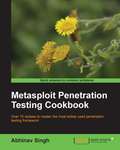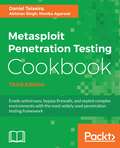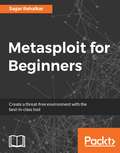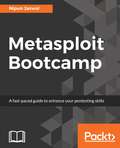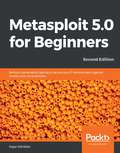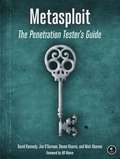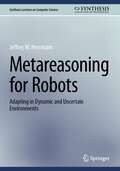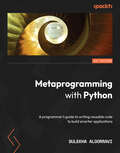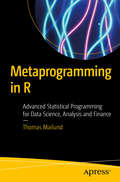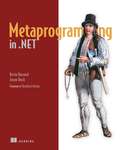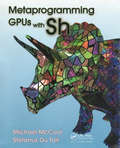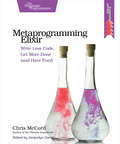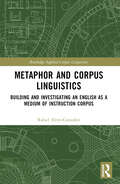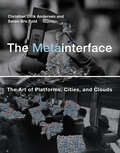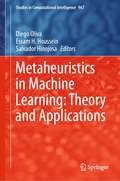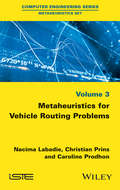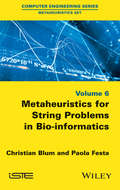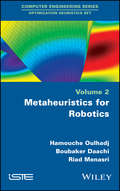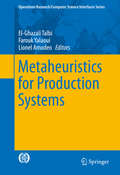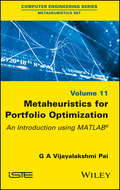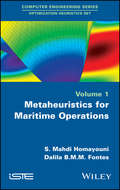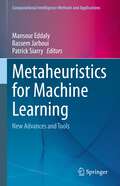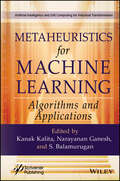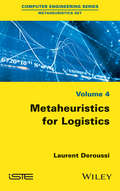- Table View
- List View
Metasploit Penetration Testing Cookbook
by Abhinav SinghThis is a Cookbook which follows a practical task-based style. There are plenty of code and commands used for illustration which make your learning curve easy and quick.This book targets both professional penetration testers as well as new users of Metasploit who wish to gain expertise over the framework. The book requires basic knowledge of scanning, exploitation, and Ruby language.
Metasploit Penetration Testing Cookbook: Evade antiviruses, bypass firewalls, and exploit complex environments with the most widely used penetration testing framework, 3rd Edition
by Daniel Teixeira Abhinav Singh Monika Agarwal Nipun JaswalOver 100 recipes for penetration testing using Metasploit and virtual machines Key Features Special focus on the latest operating systems, exploits, and penetration testing techniques Learn new anti-virus evasion techniques and use Metasploit to evade countermeasures Automate post exploitation with AutoRunScript Exploit Android devices, record audio and video, send and read SMS, read call logs, and much more Build and analyze Metasploit modules in Ruby Integrate Metasploit with other penetration testing tools Book Description Metasploit is the world's leading penetration testing tool and helps security and IT professionals find, exploit, and validate vulnerabilities. Metasploit allows penetration testing automation, password auditing, web application scanning, social engineering, post exploitation, evidence collection, and reporting. Metasploit's integration with InsightVM (or Nexpose), Nessus, OpenVas, and other vulnerability scanners provides a validation solution that simplifies vulnerability prioritization and remediation reporting. Teams can collaborate in Metasploit and present their findings in consolidated reports. In this book, you will go through great recipes that will allow you to start using Metasploit effectively. With an ever increasing level of complexity, and covering everything from the fundamentals to more advanced features in Metasploit, this book is not just for beginners but also for professionals keen to master this awesome tool. You will begin by building your lab environment, setting up Metasploit, and learning how to perform intelligence gathering, threat modeling, vulnerability analysis, exploitation, and post exploitation—all inside Metasploit. You will learn how to create and customize payloads to evade anti-virus software and bypass an organization's defenses, exploit server vulnerabilities, attack client systems, compromise mobile phones, automate post exploitation, install backdoors, run keyloggers, highjack webcams, port public exploits to the framework, create your own modules, and much more. What you will learn Set up a complete penetration testing environment using Metasploit and virtual machines Master the world's leading penetration testing tool and use it in professional penetration testing Make the most of Metasploit with PostgreSQL, importing scan results, using workspaces, hosts, loot, notes, services, vulnerabilities, and exploit results Use Metasploit with the Penetration Testing Execution Standard methodology Use MSFvenom efficiently to generate payloads and backdoor files, and create shellcode Leverage Metasploit's advanced options, upgrade sessions, use proxies, use Meterpreter sleep control, and change timeouts to be stealthy Who this book is for If you are a Security professional or pentester and want to get into vulnerability exploitation and make the most of the Metasploit framework, then this book is for you. Some prior understanding of penetration testing and Metasploit is required.
Metasploit for Beginners: Perform Penetration Testing To Secure Your It Environment Against Threats And Vulnerabilities, 2nd Edition
by Sagar RahalkarAn easy to digest practical guide to Metasploit covering all aspects of the framework from installation, configuration, and vulnerability hunting to advanced client side attacks and anti-forensics. About This Book • Carry out penetration testing in highly-secured environments with Metasploit • Learn to bypass different defenses to gain access into different systems. • A step-by-step guide that will quickly enhance your penetration testing skills. Who This Book Is For If you are a penetration tester, ethical hacker, or security consultant who wants to quickly learn the Metasploit framework to carry out elementary penetration testing in highly secured environments then, this book is for you. What You Will Learn • Get to know the absolute basics of the Metasploit framework so you have a strong foundation for advanced attacks • Integrate and use various supporting tools to make Metasploit even more powerful and precise • Set up the Metasploit environment along with your own virtual testing lab • Use Metasploit for information gathering and enumeration before planning the blueprint for the attack on the target system • Get your hands dirty by firing up Metasploit in your own virtual lab and hunt down real vulnerabilities • Discover the clever features of the Metasploit framework for launching sophisticated and deceptive client-side attacks that bypass the perimeter security • Leverage Metasploit capabilities to perform Web application security scanning In Detail This book will begin by introducing you to Metasploit and its functionality. Next, you will learn how to set up and configure Metasploit on various platforms to create a virtual test environment. You will also get your hands on various tools and components used by Metasploit. Further on in the book, you will learn how to find weaknesses in the target system and hunt for vulnerabilities using Metasploit and its supporting tools. Next, you'll get hands-on experience carrying out client-side attacks. Moving on, you'll learn about web application security scanning and bypassing anti-virus and clearing traces on the target system post compromise. This book will also keep you updated with the latest security techniques and methods that can be directly applied to scan, test, hack, and secure networks and systems with Metasploit. By the end of this book, you'll get the hang of bypassing different defenses, after which you'll learn how hackers use the network to gain access into different systems. Style and approach This tutorial is packed with step-by-step instructions that are useful for those getting started with Metasploit. This is an easy-to-read guide to learning Metasploit from scratch that explains simply and clearly all you need to know to use this essential IT power tool.
Metasploit Bootcamp
by Nipun JaswalMaster the art of penetration testing with Metasploit Framework in 7 days About This Book • A fast-paced guide that will quickly enhance your penetration testing skills in just 7 days • Carry out penetration testing in complex and highly-secured environments. • Learn techniques to Integrate Metasploit with industry's leading tools Who This Book Is For If you are a penetration tester, ethical hacker, or security consultant who quickly wants to master the Metasploit framework and carry out advanced penetration testing in highly secured environments then, this book is for you. What You Will Learn • Get hands-on knowledge of Metasploit • Perform penetration testing on services like Databases, VOIP and much more • Understand how to Customize Metasploit modules and modify existing exploits • Write simple yet powerful Metasploit automation scripts • Explore steps involved in post-exploitation on Android and mobile platforms. In Detail The book starts with a hands-on Day 1 chapter, covering the basics of the Metasploit framework and preparing the readers for a self-completion exercise at the end of every chapter. The Day 2 chapter dives deep into the use of scanning and fingerprinting services with Metasploit while helping the readers to modify existing modules according to their needs. Following on from the previous chapter, Day 3 will focus on exploiting various types of service and client-side exploitation while Day 4 will focus on post-exploitation, and writing quick scripts that helps with gathering the required information from the exploited systems. The Day 5 chapter presents the reader with the techniques involved in scanning and exploiting various services, such as databases, mobile devices, and VOIP. The Day 6 chapter prepares the reader to speed up and integrate Metasploit with leading industry tools for penetration testing. Finally, Day 7 brings in sophisticated attack vectors and challenges based on the user's preparation over the past six days and ends with a Metasploit challenge to solve. Style and approach This book is all about fast and intensive learning. That means we don't waste time in helping readers get started. The new content is basically about filling in with highly-effective examples to build new things, show solving problems in newer and unseen ways, and solve real-world examples.
Metasploit 5.0 for Beginners: Perform penetration testing to secure your IT environment against threats and vulnerabilities, 2nd Edition
by Sagar RahalkarA comprehensive guide to Metasploit for beginners that will help you get started with the latest Metasploit 5.0 Framework for exploiting real-world vulnerabilities Key Features Perform pentesting in highly secured environments with Metasploit 5.0 Become well-versed with the latest features and improvements in the Metasploit Framework 5.0 Analyze, find, exploit, and gain access to different systems by bypassing various defenses Book Description Securing an IT environment can be challenging, however, effective penetration testing and threat identification can make all the difference. This book will help you learn how to use the Metasploit Framework optimally for comprehensive penetration testing. Complete with hands-on tutorials and case studies, this updated second edition will teach you the basics of the Metasploit Framework along with its functionalities. You'll learn how to set up and configure Metasploit on various platforms to create a virtual test environment. Next, you'll get hands-on with the essential tools. As you progress, you'll learn how to find weaknesses in the target system and hunt for vulnerabilities using Metasploit and its supporting tools and components. Later, you'll get to grips with web app security scanning, bypassing anti-virus, and post-compromise methods for clearing traces on the target system. The concluding chapters will take you through real-world case studies and scenarios that will help you apply the knowledge you've gained to ethically hack into target systems. You'll also discover the latest security techniques that can be directly applied to scan, test, ethically hack, and secure networks and systems with Metasploit. By the end of this book, you'll have learned how to use the Metasploit 5.0 Framework to exploit real-world vulnerabilities. What you will learn Set up the environment for Metasploit Understand how to gather sensitive information and exploit vulnerabilities Get up to speed with client-side attacks and web application scanning using Metasploit Leverage the latest features of Metasploit 5.0 to evade anti-virus Delve into cyber attack management using Armitage Understand exploit development and explore real-world case studies Who this book is for If you are a penetration tester, ethical hacker, or security consultant who wants to quickly get started with using the Metasploit Framework to carry out elementary penetration testing in highly secured environments, then this Metasploit book is for you. You will also find this book useful if you're interested in computer security, particularly in the areas of vulnerability assessment and pentesting, and want to develop practical skills when using the Metasploit Framework.
Metasploit
by David Kennedy Devon Kearns Jim O'Gorman Mati Aharoni<p>The Metasploit Framework makes discovering, exploiting, and sharing vulnerabilities quick and relatively painless. But while Metasploit is used by security professionals everywhere, the tool can be hard to grasp for first-time users. <p>Metasploit: The Penetration Tester's Guide fills this gap by teaching you how to harness the Framework and interact with the vibrant community of Metasploit contributors.Once you've built your foundation for penetration testing, you’ll learn the Framework's conventions, interfaces, and module system as you launch simulated attacks. You’ll move on to advanced penetration testing techniques, including network reconnaissance and enumeration, client-side attacks, wireless attacks, and targeted social-engineering attacks.Learn how to:–Find and exploit unmaintained, misconfigured, and unpatched systems–Perform reconnaissance and find valuable information about your target–Bypass anti-virus technologies and circumvent security controls–Integrate Nmap, NeXpose, and Nessus with Metasploit to automate discovery–Use the Meterpreter shell to launch further attacks from inside the network–Harness standalone Metasploit utilities, third-party tools, and plug-ins–Learn how to write your own Meterpreter post exploitation modules and scriptsYou'll even touch on exploit discovery for zero-day research, write a fuzzer, port existing exploits into the Framework, and learn how to cover your tracks. Whether your goal is to secure your own networks or to put someone else's to the test, Metasploit: The Penetration Tester's Guide will take you there and beyond.
Metareasoning for Robots: Adapting in Dynamic and Uncertain Environments (Synthesis Lectures on Computer Science)
by Jeffrey W. HerrmannThis book is a state of the art resource that robotics researchers and engineers can use to make their robots and autonomous vehicles smarter. Readers will be able to describe metareasoning, select an appropriate metareasoning approach, and synthesize metareasoning policies. Metareasoning for Robots adopts a systems engineering perspective in which metareasoning is an approach that can improve the overall robot or autonomous system, not just one component or subsystem. This book introduces key concepts, discusses design options for metareasoning approaches and policies, and presents approaches for testing and evaluation of metareasoning policies. After considering the conceptual design phase, it discusses how to implement metareasoning in the robot’s software architecture and how to synthesize metareasoning policies. Every chapter has references to valuable works on robotics and metareasoning, and the book uses examples from the author’s own research and from other research groups to illustrate these ideas. In addition, this book provides links to books and papers for readers who wish to investigate these topics further.
Metaprogramming with Python: A programmer's guide to writing reusable code to build smarter applications
by Sulekha AloorRaviA practical approach to metaprogramming with real-world examples that enables the development of advanced frameworks, libraries, and applications using PythonKey FeaturesLearn applied metaprogramming through a simple step-by-step approachWork with easily understandable examples and explanations that take you deep into the theory of metaprogrammingGet practical experience in writing reusable code with real-world examplesBook DescriptionEffective and reusable code makes your application development process seamless and easily maintainable. With Python, you will have access to advanced metaprogramming features that you can use to build high-performing applications. The book starts by introducing you to the need and applications of metaprogramming, before navigating the fundamentals of object-oriented programming. Next, you will learn about simple decorators, work with metaclasses, and later focus on introspection and reflection. You'll also delve into generics and typing before defining templates for algorithms. As you progress, you will understand your code using abstract syntax trees and explore method resolution order. This Python book also shows you how to create your own dynamic objects before structuring the objects through design patterns. Finally, you will learn simple code-generation techniques along with discovering best practices and eventually building your own applications. By the end of this learning journey, you'll have acquired the skills and confidence you need to design and build reusable high-performing applications that can solve real-world problems.What you will learnUnderstand the programming paradigm of metaprogramming and its needRevisit the fundamentals of object-oriented programmingDefine decorators and work with metaclassesEmploy introspection and reflection on your codeApply generics, typing, and templates to enhance your codeGet to grips with the structure of your code through abstract syntax trees and the behavior through method resolution orderCreate dynamic objects and generate dynamic codeUnderstand various design patterns and best practicesWho this book is forIf you are an intermediate-level Python programmer looking to enhance your coding skills by developing reusable and advanced frameworks, then this book is for you. Basic knowledge of Python programming will help you get the most out of this learning journey.
Metaprogramming in R
by Thomas MailundLearn how to manipulate functions and expressions to modify how the R language interprets itself. This book is an introduction to metaprogramming in the R language, so you will write programs to manipulate other programs. Metaprogramming in R shows you how to treat code as data that you can generate, analyze, or modify. R is a very high-level language where all operations are functions and all functions are data that can be manipulated. This book shows you how to leverage R's natural flexibility in how function calls and expressions are evaluated, to create small domain-specific languages to extend R within the R language itself. What You'll Learn Find out about the anatomy of a function in R Look inside a function call Work with R expressions and environments Manipulate expressions in R Use substitutions Who This Book Is For Those with at least some experience with R and certainly for those with experience in other programming languages.
Metaprogramming in .NET
by Jason Bock Kevin HazzardSummaryMetaprogramming in .NET is designed to help readers understand the basic concepts, advantages, and potential pitfalls of metaprogramming. It introduces core concepts in clear, easy-to-follow language and then it takes you on a deep dive into the tools and techniques you'll use to implement them in your .NET code. You'll explore plenty of real-world examples that reinforce key concepts. When you finish, you'll be able to build high-performance, metaprogramming-enabled software with confidence.About the TechnologyWhen you write programs that create or modify other programs, you are metaprogramming. In .NET, you can use reflection as well as newer concepts like code generation and scriptable software. The emerging Roslyn project exposes the .NET compiler as an interactive API, allowing compile-time code analysis and just-in-time refactoring.About this BookMetaprogramming in .NET is a practical introduction to the use of metaprogramming to improve the performance and maintainability of your code. This book avoids abstract theory and instead teaches you solid practices you'll find useful immediately. It introduces core concepts like code generation and application composition in clear, easy-to-follow language.Written for readers comfortable with C# and the .NET framework—no prior experience with metaprogramming is required.Purchase of the print book comes with an offer of a free PDF, ePub, and Kindle eBook from Manning. Also available is all code from the book. What's InsideMetaprogramming concepts in plain languageCreating scriptable softwareCode generation techniquesThe Dynamic Language RuntimeAbout the AuthorsKevin Hazzard is a Microsoft MVP, consultant, teacher, and developer community leader in the mid-Atlantic USA. Jason Bock is an author, Microsoft MVP, and the leader of the Twin Cities Code Camp."An excellent way to start fully using the power of metaprogramming."—From the Foreword by Rockford Lhotka, Creator of the CSLA .NET FrameworkTable of ContentsPART 1 DEMYSTIFYING METAPROGRAMMINGMetaprogramming conceptsExploring code and metadata with reflectionPART 2 TECHNIQUES FOR GENERATING CODEThe Text Template Transformation Toolkit (T4)Generating code with the CodeDOMGenerating code with Reflection.EmitGenerating code with expressionsGenerating code with IL rewritingPART 3 LANGUAGES AND TOOLSThe Dynamic Language RuntimeLanguages and toolsManaging the .NET Compiler
Metaprogramming GPUs with Sh
by Michael McCool Stefanus Du ToitThis book is a high-level overview of Sh and its relationship to other realtime shading and Graphics processing unit programming languages. It is a reference manual and language specification and methodically and exhaustively presents details of the various features of Sh.
Metaprogramming Elixir: Write Less Code, Get More Done (and Have Fun!)
by Chris McCordWrite code that writes code with Elixir macros. Macros make metaprogramming possible and define the language itself. In this book, you'll learn how to use macros to extend the language with fast, maintainable code and share functionality in ways you never thought possible. You'll discover how to extend Elixir with your own first-class features, optimize performance, and create domain-specific languages. Metaprogramming is one of Elixir's greatest features. Maybe you've played with the basics or written a few macros. Now you want to take it to the next level. This book is a guided series of metaprogramming tutorials that take you step by step to metaprogramming mastery. You'll extend Elixir with powerful features and write faster, more maintainable programs in ways unmatched by other languages.You'll start with the basics of Elixir's metaprogramming system and find out how macros interact with Elixir's abstract format. Then you'll extend Elixir with your own first-class features, write a testing framework, and discover how Elixir treats source code as building blocks, rather than rote lines of instructions. You'll continue your journey by using advanced code generation to create essential libraries in strikingly few lines of code. Finally, you'll create domain-specific languages and learn when and where to apply your skills effectively.When you're done, you will have mastered metaprogramming, gained insights into Elixir's internals, and have the confidence to leverage macros to their full potential in your own projects.
Metaphors for Musicians
by Randy Halberstadt Sher MusicThis practical and enlightening book gives insight into almost every aspect of jazz musicianship---scale/chord theory, composing techniques, analyzing tunes, practice strategies, etc. For any level of player, on any instrument. Endorsed by Jessica Wiliams, Jerry Bergonzi, Bill mays, etc.
Metaphor and Corpus Linguistics: Building and Investigating an English as a Medium of Instruction Corpus (Routledge Applied Corpus Linguistics)
by Rafael Alejo-GonzálezMetaphor and Corpus Linguistics: Building and Investigating an English as a Medium of Instruction Corpus offers a model for building a corpus of oral EMI seminars. It demonstrates how incorporating metaphor to the process of corpus building affords a more comprehensive description of the role of metaphor in discourse. EMI is the specific context outlined in this volume, and as such it will be of particular interest to researchers in this area, though the design and model can be easily generalised and applied to other corpora focusing on metaphor. Alejo-González argues for the need to build such a corpus given the scarcity of corpora being tagged for metaphor as well as the shortage of those dealing with the EMI phenomenon. This book will be of practical use and interest to those researchers of corpus linguistics or related areas looking to explore metaphor through their corpus studies.
The Metainterface: The Art of Platforms, Cities, and Clouds (The\mit Press Ser.)
by Christian Ulrik Andersen Soren Bro PoldHow the interface has moved from the PC into cultural platforms, as seen in a series of works of net art, software art and electronic literature.The computer interface is both omnipresent and invisible, at once embedded in everyday objects and characterized by hidden exchanges of information between objects. The interface has moved from office into culture, with devices, apps, the cloud, and data streams as new cultural platforms. In The Metainterface, Christian Ulrik Andersen and Søren Bro Pold examine the relationships between art and interfaces, tracing the interface's disruption of everyday cultural practices. They present a new interface paradigm of cloud services, smartphones, and data capture, and examine how particular art forms—including net art, software art, and electronic literature—seek to reflect and explore this paradigm.Andersen and Pold argue that despite attempts to make the interface disappear into smooth access and smart interaction, it gradually resurfaces; there is a metainterface to the displaced interface. Art can help us see this; the interface can be an important outlet for aesthetic critique. Andersen and Pold describe the “semantic capitalism” of a metainterface industry that captures user behavior; the metainterface industry's disruption of everyday urban life, changing how the city is read, inhabited, and organized; the ways that the material displacement of the cloud affects the experience of the interface; and the potential of designing with an awareness of the language and grammar of interfaces.
Metaheuristics in Machine Learning: Theory and Applications (Studies in Computational Intelligence #967)
by Diego Oliva Salvador Hinojosa Essam H. HousseinThis book is a collection of the most recent approaches that combine metaheuristics and machine learning. Some of the methods considered in this book are evolutionary, swarm, machine learning, and deep learning. The chapters were classified based on the content; then, the sections are thematic. Different applications and implementations are included; in this sense, the book provides theory and practical content with novel machine learning and metaheuristic algorithms.The chapters were compiled using a scientific perspective. Accordingly, the book is primarily intended for undergraduate and postgraduate students of Science, Engineering, and Computational Mathematics and is useful in courses on Artificial Intelligence, Advanced Machine Learning, among others. Likewise, the book is useful for research from the evolutionary computation, artificial intelligence, and image processing communities.
Metaheuristics for Vehicle Routing Problems
by Nacima Labadie Caroline Prodhon Christian PrinsThis book is dedicated to metaheuristics as applied to vehicle routing problems. Several implementations are given as illustrative examples, along with applications to several typical vehicle routing problems. As a first step, a general presentation intends to make the reader more familiar with the related field of logistics and combinatorial optimization. This preamble is completed with a description of significant heuristic methods classically used to provide feasible solutions quickly, and local improvement moves widely used to search for enhanced solutions. The overview of these fundamentals allows appreciating the core of the work devoted to an analysis of metaheuristic methods for vehicle routing problems. Those methods are exposed according to their feature of working either on a sequence of single solutions, or on a set of solutions, or even by hybridizing metaheuristic approaches with others kind of methods.
Metaheuristics for String Problems in Bio-informatics
by Christian Blum Paola FestaThis book will present the latest research on metaheuristic algorithms for some of the most important string problems in bio-informatics. Optimization problems related to strings---such as protein or DNA sequences---are very common in bioinformatics. Examples include string selection problems such as the "far from most string" problem, and other string problems such as the longest common subsequence problem and its variants, alignment problems, and similarity search. These problems are often computationally very hard. Therefore, during the last 10-15 years the research community has focused especially on metaheuristic algorithms for solving this type of problems. This book aims at presenting some of the most interesting recent work in this line of research.
Metaheuristics for Robotics
by Hamouche Oulhadj Boubaker Daachi Riad MenasriThis book is dedicated to the application of metaheuristic optimization in trajectory generation and control issues in robotics. In this area, as in other fields of application, the algorithmic tools addressed do not require a comprehensive list of eligible solutions to effectively solve an optimization problem. This book investigates how, by reformulating the problems to be solved, it is possible to obtain results by means of metaheuristics. Through concrete examples and case studies – particularly related to robotics – this book outlines the essentials of what is needed to reformulate control laws into concrete optimization data. The resolution approaches implemented – as well as the results obtained – are described in detail, in order to give, as much as possible, an idea of metaheuristics and their performance within the context of their application to robotics.
Metaheuristics for Production Systems
by El-Ghazali Talbi Farouk Yalaoui Lionel AmodeoThis book discusses the main techniques and newest trends to manage and optimize the production and service systems. The book begins by examining the three main levels of decision systems in production: the long term (strategic), the middle term (tactical) and short term (operational). It also considers online management as a new level (a sub level of the short term). As each level encounters specific problems, appropriate approaches to deal with these are introduced and explained. These problems include the line design, the line balancing optimization, the physical layout of the production or service system, the forecasting optimization, the inventory management, the scheduling etc. Metaheuristics for Production Systems then explores logistic optimization from two different perspectives: internal (production management), addressing issues of scheduling, layout and line designs, and external (supply chain management) focusing on transportation optimization, supply chain evaluation, and location of production. The book also looks at NP-hard problems that are common in production management. These complex configurations may mean that optimal solutions may not be reached due to variables, but the authors help provide a good solution for such problems. The effective new results and solutions offered in this book should appeal to researchers, managers, and engineers in the production and service industries.
Metaheuristics for Portfolio Optimization: An Introduction using MATLAB
by G. A. Vijayalakshmi PaiThe book is a monograph in the cross disciplinary area of Computational Intelligence in Finance and elucidates a collection of practical and strategic Portfolio Optimization models in Finance, that employ Metaheuristics for their effective solutions and demonstrates the results using MATLAB implementations, over live portfolios invested across global stock universes. The book has been structured in such a way that, even novices in finance or metaheuristics should be able to comprehend and work on the hybrid models discussed in the book.
Metaheuristics for Maritime Operations
by S. Mahdi Homayouni Dalila B.M.M. FontesMetaheuristic Algorithms in Maritime Operations Optimization focuses on the seaside and port side problems regarding the maritime transportation. The book reviews and introduces the most important problems regarding the shipping network design, long-term and short-term scheduling and planning problems in both bulk and container shipping as well as liquid maritime transportation. Application of meta heuristic algorithm is important for these problems, as most of them are hard and time-consuming to be solved optimally.
Metaheuristics for Machine Learning: New Advances and Tools (Computational Intelligence Methods and Applications)
by Mansour Eddaly Bassem Jarboui Patrick SiarryUsing metaheuristics to enhance machine learning techniques has become trendy and has achieved major successes in both supervised (classification and regression) and unsupervised (clustering and rule mining) problems. Furthermore, automatically generating programs via metaheuristics, as a form of evolutionary computation and swarm intelligence, has now gained widespread popularity. This book investigates different ways of integrating metaheuristics into machine learning techniques, from both theoretical and practical standpoints. It explores how metaheuristics can be adapted in order to enhance machine learning tools and presents an overview of the main metaheuristic programming methods. Moreover, real-world applications are provided for illustration, e.g., in clustering, big data, machine health monitoring, underwater sonar targets, and banking.
Metaheuristics for Machine Learning: Algorithms and Applications (Artificial Intelligence and Soft Computing for Industrial Transformation)
by Kanak Kalita Narayanan Ganesh S. BalamuruganMETAHEURISTICS for MACHINE LEARNING The book unlocks the power of nature-inspired optimization in machine learning and presents a comprehensive guide to cutting-edge algorithms, interdisciplinary insights, and real-world applications. The field of metaheuristic optimization algorithms is experiencing rapid growth, both in academic research and industrial applications. These nature-inspired algorithms, which draw on phenomena like evolution, swarm behavior, and neural systems, have shown remarkable efficiency in solving complex optimization problems. With advancements in machine learning and artificial intelligence, the application of metaheuristic optimization techniques has expanded, demonstrating significant potential in optimizing machine learning models, hyperparameter tuning, and feature selection, among other use-cases. In the industrial landscape, these techniques are becoming indispensable for solving real-world problems in sectors ranging from healthcare to cybersecurity and sustainability. Businesses are incorporating metaheuristic optimization into machine learning workflows to improve decision-making, automate processes, and enhance system performance. As the boundaries of what is computationally possible continue to expand, the integration of metaheuristic optimization and machine learning represents a pioneering frontier in computational intelligence, making this book a timely resource for anyone involved in this interdisciplinary field. Metaheuristics for Machine Learning: Algorithms and Applications serves as a comprehensive guide to the intersection of nature-inspired optimization and machine learning. Authored by leading experts, this book seamlessly integrates insights from computer science, biology, and mathematics to offer a panoramic view of the latest advancements in metaheuristic algorithms. You’ll find detailed yet accessible discussions of algorithmic theory alongside real-world case studies that demonstrate their practical applications in machine learning optimization. Perfect for researchers, practitioners, and students, this book provides cutting-edge content with a focus on applicability and interdisciplinary knowledge. Whether you aim to optimize complex systems, delve into neural networks, or enhance predictive modeling, this book arms you with the tools and understanding you need to tackle challenges efficiently. Equip yourself with this essential resource and navigate the ever-evolving landscape of machine learning and optimization with confidence. Audience The book is aimed at a broad audience encompassing researchers, practitioners, and students in the fields of computer science, data science, engineering, and mathematics. The detailed but accessible content makes it a must-have for both academia and industry professionals interested in the optimization aspects of machine learning algorithms.
Metaheuristics for Logistics
by Laurent DeroussiThis book describes the main classical combinatorial problems that can be encountered when designing a logistics network or driving a supply chain. It shows how these problems can be tackled by metaheuristics, both separately and using an integrated approach. A huge number of techniques, from the simplest to the most advanced ones, are given for helping the reader to implement efficient solutions that meet its needs. A lot of books have been written about metaheuristics (methods for solving hard optimization problems) and supply chain management (the field in which we find a huge number of combinatorial optimization problems) in the last decades. So, the main reason of this book is to describe how these methods can be implemented for this class of problems.
